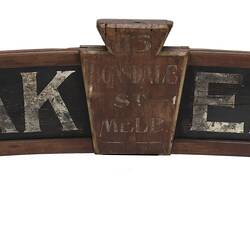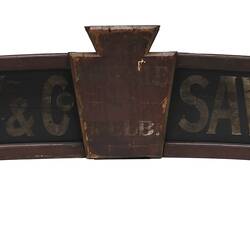Summary
Wooden sign painted with the trade name of "WH Blakeley & Co".
William Henry Blakeley (1839-1921) migrated to Victoria in 1865. Trained as a saw maker in Sheffield, England, Blakeley established a business as a 'saw doctor' at 150 Little Bourke Street in 1867. At that time there were eight "Saw & Tool Makers" listed in the Sands & McDougall Melbourne directory, including Blakeley. By 1868, he had moved his business to 110 Russell St and from 1874 he is listed at 116 Russell Street. By 1890, he was operating from premises at 115 Lonsdale Street and by 1898 his trading name was listed as "W. H. Blakeley & Co.", instead of just "W. H. Blakeley".
By 1883 W. H. Blakeley was stocking Henry Disston & Sons saws and advertising himself as an Agent for their "Circular and Vertical Saws" as well as "Importer of English and American Saws, Tools and Files". Disston branded saws had been available in Australia for several years and displayed at various exhibitions. Henry Disston & Sons of Philadelphia U.S.A. was the largest and most renowned manufacturer of saws in the world at that time.
In 1884 and 1888, Blakeley exhibited a display of Disston saws and his own branded saws. In a contemporary photograph of the Disston display, there is a sign that is very similar in shape and design to the "WH Blakeley & Co." sign. Henry Disston & Sons called their manufacturing plant the "Keystone Saw, Tool, Steel and File Works" and the 'keystone' shape shown in the middle of the sign, along with an image of a set of balance scales, was the company symbol. Because of its similarity, it is possible that the "WH Blakeley" sign was also featured at these Exhibitions, above his own saw display. It is also possible that Blakeley later painted over the Disston sign with his own business name (as W. H. Blakeley & Co. by 1898) or the sign may have had Disston on one side and Blakeley on the other.
After the Exhibitions, the sign was displayed at the Blakeley manufacturing works. It was later loaned by the family to the Coal Creek Heritage Village, Korumburra. It was returned to the Blakeley family and was stored at their factory in North Clayton since early 2000s until donated to the museum in 2014.
Physical Description
Curved wooden sign in the shape of a banner with a keystone shaped piece in the centre. Painted inscription on both sides.
More Information
-
Collecting Areas
-
Acquisition Information
Donation from Ms Hazel Blakeley, Ms Helen Blakeley, Ms Rosalie Blakeley, 17 Apr 2014
-
Manufacturer
William H. Blakeley, Russell Street, Melbourne, Greater Melbourne, Victoria, Australia, 1884
-
Made For
-
Inscriptions
On keystone shape: ' 115/LONSDALE/ST/MELB ' On one side: ' W.H. BLAK [keystone] ELEY & Co ' On other side: ' W.H. BLAKELEY & Co [keystone] SAW MANUFTRS '
-
Classification
Manufacturing & industry, Engineering products, Machine tools
-
Category
-
Discipline
-
Type of item
-
Overall Dimensions
3600 mm (Width), 165 mm (Depth), 700 mm (Height)
-
Keywords
Signage, Signs, Saw Blades, Sawmilling Equipment, Saws, Saw Sharpeners, Exhibitions: Melbourne Intercolonial, Victorian Jubilee, 1884-1885, Exhibitions: Melbourne International Centennial, 1888-1889


